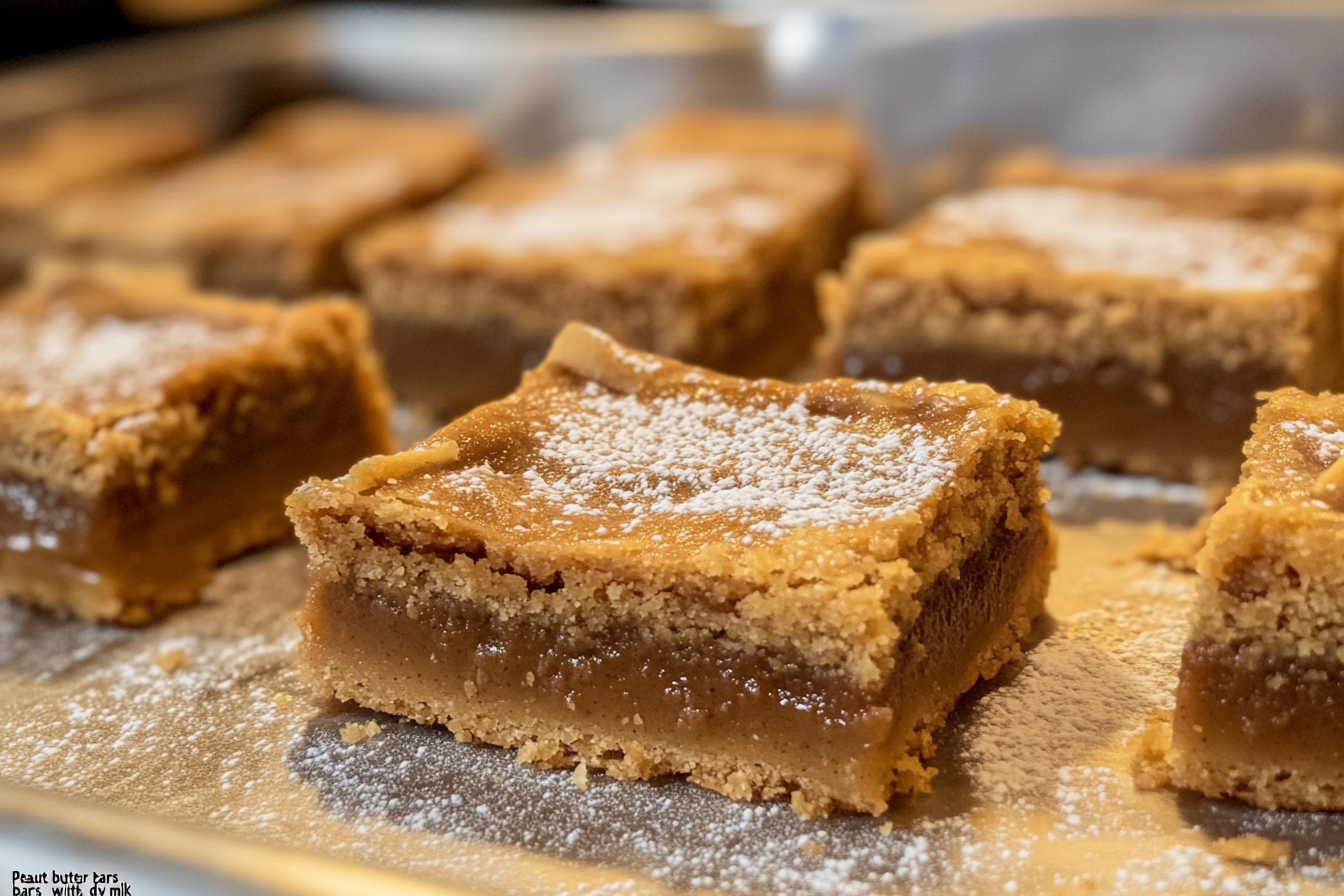Peanut Butter Bars with Dry Milk are a delicious and simple no-bake dessert that combines the creamy richness of peanut butter with the smooth texture of dry milk. These bars are perfect for quick snacks, satisfying dessert cravings, or preparing ahead for gatherings. With minimal ingredients and no oven required, they’re a versatile treat anyone can make.
Introduction to Peanut Butter Bars
Peanut butter bars are a staple in no-bake dessert recipes. They’re:
- Convenient: Ready in under 30 minutes with no baking required.
- Customizable: Easily adapted to suit different tastes and dietary needs.
- Nutritious: Packed with protein and healthy fats.
Why Use Dry Milk in Dessert Recipes
Dry milk enhances the texture and flavor of these bars while adding nutritional benefits:
- Creamy Texture: It helps create a smooth, fudgy consistency without adding extra liquid.
- Nutritional Boost: Adds calcium, protein, and vitamins to the recipe.
- Long Shelf Life: Makes it a handy ingredient to have in your pantry for quick recipes.
Nutritional Benefits of Peanut Butter and Dry Milk
Peanut Butter as a Source of Healthy Fats and Protein
- High in monounsaturated fats, which support heart health.
- Contains plant-based protein for sustained energy and satiety.
- Provides essential nutrients like vitamin E and magnesium.
Dry Milk for Creamy Texture and Added Calcium
- Rich in calcium for bone health.
- Contains protein and B vitamins, making it a nutritious addition to the recipe.
Essential Ingredients for Peanut Butter Bars
Choosing the Right Peanut Butter
- Natural Peanut Butter: Ideal for a creamy, rich flavor without added sugar or oils.
- Crunchy Peanut Butter: Adds texture to the bars.
Selecting Sweeteners: Honey, Sugar, or Maple Syrup
- Honey: Provides natural sweetness and helps bind the ingredients.
- Maple Syrup: Adds a unique flavor while keeping the recipe refined sugar-free.
- Powdered Sugar: For a sweeter, more traditional dessert.
Using Dry Milk: Tips for Measuring and Mixing
- Use instant dry milk for easy incorporation into the mixture.
- Sift the dry milk to avoid lumps when mixing.
Kitchen Tools and Preparation Essentials
Mixing Bowls, Measuring Cups, and Spatulas
- Mixing Bowls: Use separate bowls for wet and dry ingredients.
- Measuring Cups: Ensure precise measurements for consistent texture.
- Spatula: Ideal for mixing and spreading the mixture evenly.
Preparing a Baking Dish or Pan for Shaping
- Line an 8×8-inch baking dish with parchment paper for easy removal.
- Lightly grease the pan if not using parchment to prevent sticking.
Step-by-Step Recipe for Peanut Butter Bars with Dry Milk
Follow this simple, no-bake recipe to create delicious peanut butter bars with dry milk. These bars are quick to make, require minimal effort, and can be customized with your favorite mix-ins and flavors.
Preparing the Ingredients
Measuring Peanut Butter, Dry Milk, and Sweeteners
- Peanut Butter: Measure 1 cup of creamy or crunchy peanut butter.
- Dry Milk: Sift 1/2 cup of instant dry milk to ensure a smooth consistency.
- Sweetener: Use 1/4 cup honey (or maple syrup for a refined sugar-free version).
- Optional Flavor Enhancers:
- Add 1/2 tsp vanilla extract for added depth.
- Sprinkle a pinch of salt if using unsalted peanut butter.
Optional Add-Ins
- Chocolate Chips: Add 1/4 cup semi-sweet or dark chocolate chips for a rich chocolatey taste.
- Nuts: Incorporate chopped almonds, pecans, or peanuts for added crunch.
- Dried Fruit: Mix in 1/4 cup raisins or dried cranberries for a fruity twist.
Mixing the Ingredients
Combining Peanut Butter, Sweeteners, and Dry Milk
- In a large mixing bowl, combine the peanut butter and honey.
- Stir until smooth and well-blended.
- Gradually add the dry milk, stirring continuously to form a thick, cohesive dough.
- If the mixture feels too dry, add 1–2 tsp of coconut oil or melted butter. If it’s too sticky, sprinkle in a little more dry milk.
Shaping and Setting the Peanut Butter Bars
Pressing the Mixture into a Baking Dish
- Line an 8×8-inch baking dish with parchment paper, leaving an overhang for easy removal.
- Transfer the mixture to the dish and spread it evenly using a spatula or the back of a spoon.
- For a smoother finish, press the mixture down with a sheet of wax paper or the bottom of a flat glass.
Chilling in the Refrigerator or Freezer
- Place the dish in the refrigerator for 1–2 hours or in the freezer for 30 minutes until the mixture firms up.
Cutting and Storing the Bars
Achieving Evenly Sized Bars
- Remove the chilled mixture from the baking dish using the parchment paper overhang.
- Place on a cutting board and use a sharp knife to cut into evenly sized bars or squares. A warm knife (dipped in hot water and wiped dry) can help create clean cuts.
Proper Storage for Freshness
- Store the bars in an airtight container with parchment paper between layers to prevent sticking.
- Keep in the refrigerator for up to 7 days or in the freezer for up to 3 months.
Customization Ideas and Serving Tips for Peanut Butter Bars with Dry Milk
Elevate your peanut butter bars with creative variations, serving suggestions, and dietary modifications. These tips ensure your bars are versatile, visually appealing, and tailored to different preferences.
Creative Variations of Peanut Butter Bars
Adding a Chocolate Layer for a Classic Treat
- Ingredients: Melt 1/2 cup semi-sweet chocolate chips with 1 tbsp coconut oil for a glossy finish.
- Steps:
- Spread the melted chocolate evenly over the pressed peanut butter mixture.
- Chill until the chocolate is set before slicing.
Incorporating Protein Powder for a Healthy Twist
- Replace 2 tbsp of dry milk with your favorite protein powder (vanilla, chocolate, or unflavored).
- This adds an extra protein boost, making the bars a great pre- or post-workout snack.
Peanut Butter and Jelly Bars
- Add a thin layer of your favorite fruit preserves (e.g., strawberry or raspberry) between the peanut butter base and chocolate layer for a nostalgic PB&J flavor.
Adjusting for Dietary Preferences
Making a Vegan Version with Plant-Based Substitutes
- Peanut Butter: Ensure your peanut butter is vegan (no honey or added dairy ingredients).
- Sweetener: Swap honey with maple syrup or agave nectar.
- Dry Milk: Replace with coconut milk powder or almond flour for a vegan-friendly alternative.
Lowering Sugar Content for a Guilt-Free Snack
- Use sugar-free peanut butter and a low-glycemic sweetener like monk fruit syrup or erythritol.
- Reduce the sweetener quantity slightly and rely on natural sweetness from optional mix-ins like dried fruit.
Presentation and Plating Ideas
Decorating Bars with Drizzles or Sprinkles
- Drizzle melted dark chocolate or white chocolate over the bars for a professional look.
- Top with toasted coconut flakes, chopped nuts, or colorful sprinkles for added texture and visual appeal.
Serving Suggestions for Parties or Snacks
- For Parties: Arrange the bars on a platter with parchment dividers for easy grabbing.
- As Snacks: Pair with fresh fruit or a cup of yogurt for a balanced treat.
- Gift Idea: Package the bars in decorative boxes or jars for homemade gifts.
Storing and Reusing Leftover Ingredients
Keeping Dry Milk and Peanut Butter Fresh
- Store dry milk in a cool, dry place, sealed tightly, to prevent clumping or spoilage.
- Keep peanut butter in a pantry (natural separation is normal—just stir before using) or refrigerate if preferred.
Using Ingredients in Other Recipes
- Dry Milk:
- Use in pancake or muffin batter for added creaminess.
- Incorporate into homemade hot cocoa mixes.
- Peanut Butter:
- Spread on toast, use in smoothies, or mix into oatmeal.
- Create peanut butter-based sauces for savory dishes.
Common Mistakes to Avoid
Ensuring the Mixture is Not Too Dry or Too Sticky
- Too Dry: Gradually add coconut oil, melted butter, or an extra spoonful of peanut butter until the texture is cohesive.
- Too Sticky: Sprinkle in additional dry milk, 1 tablespoon at a time, until manageable.
Properly Setting the Bars for Easy Cutting
- Chill thoroughly before slicing to avoid crumbling or uneven cuts.
- Use a sharp, non-serrated knife for clean lines, wiping the blade between cuts.

